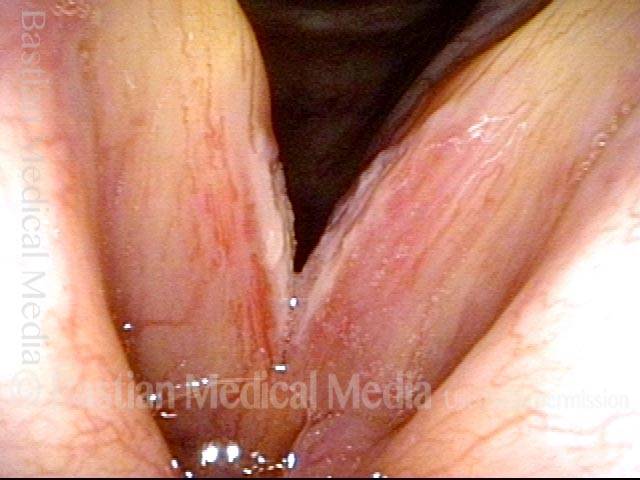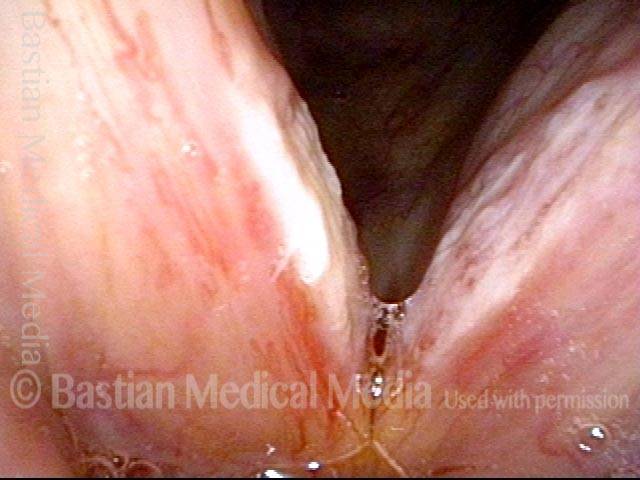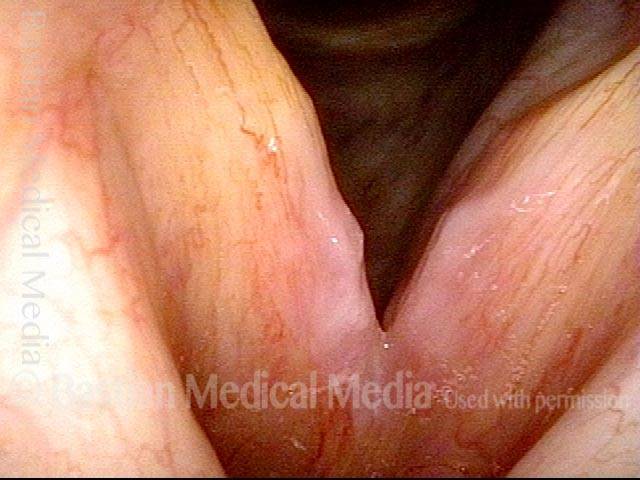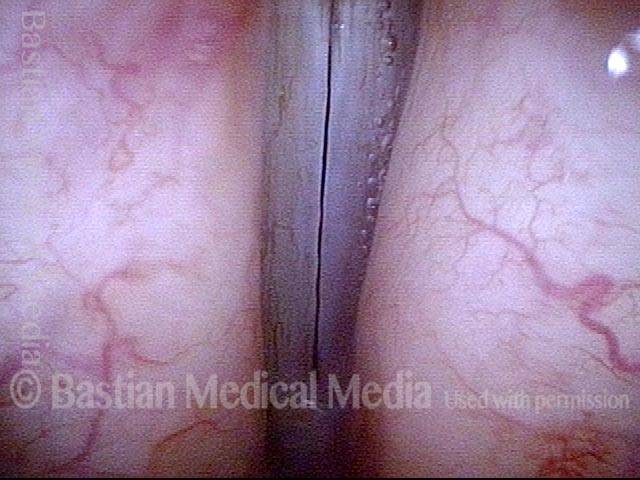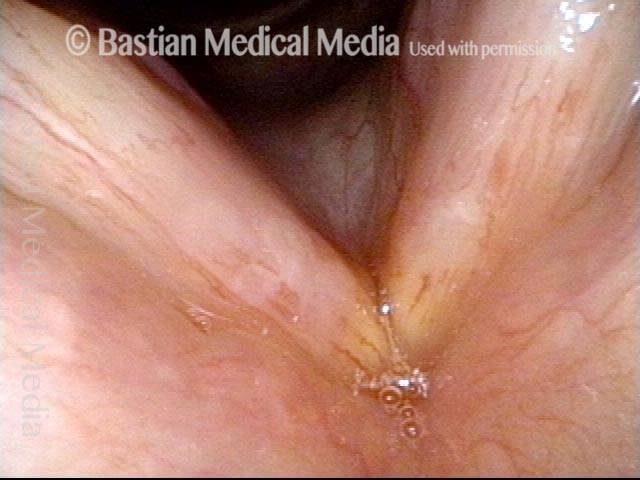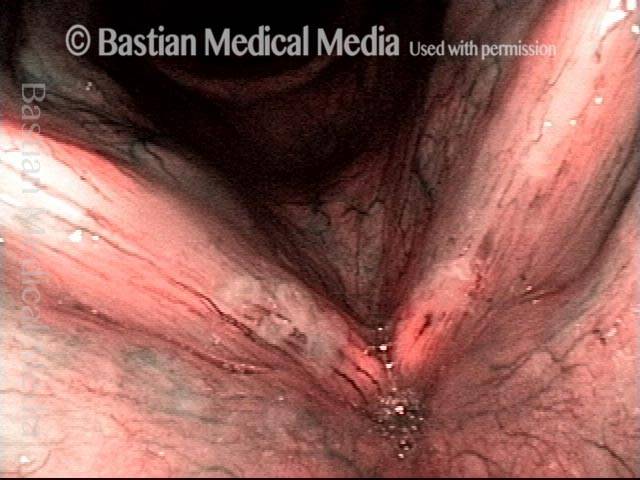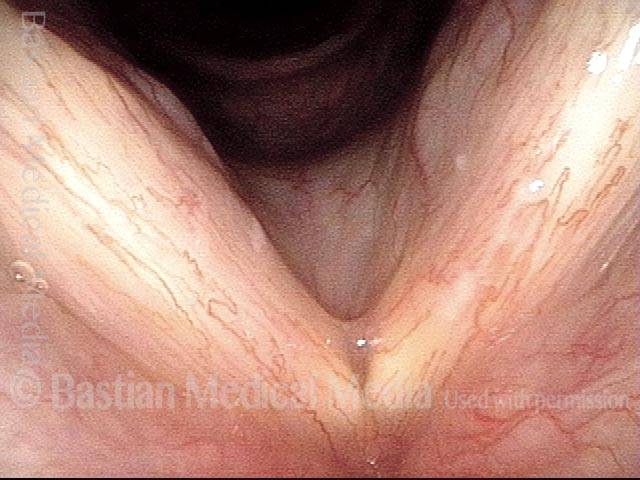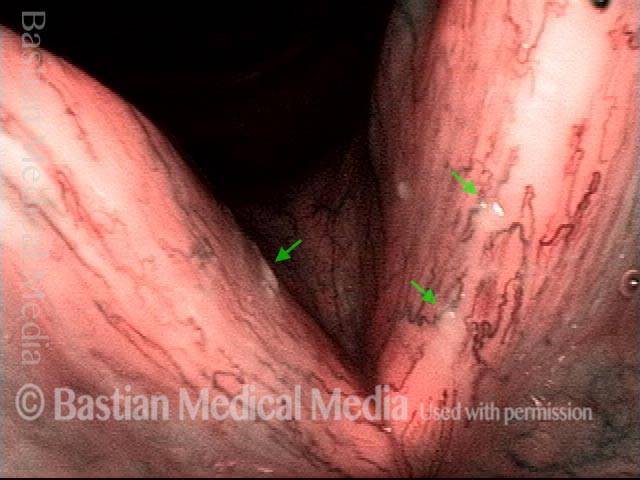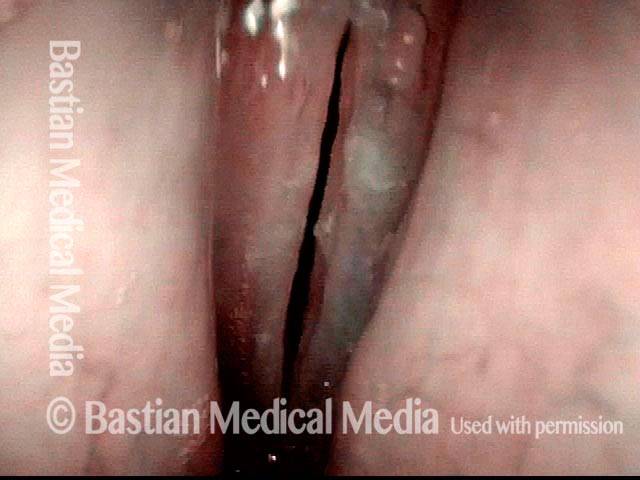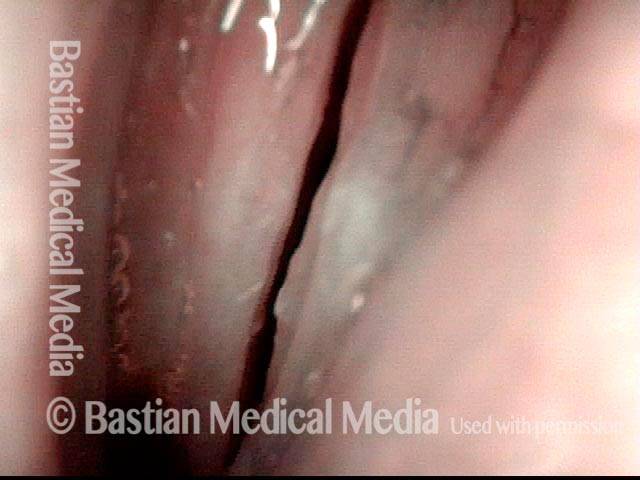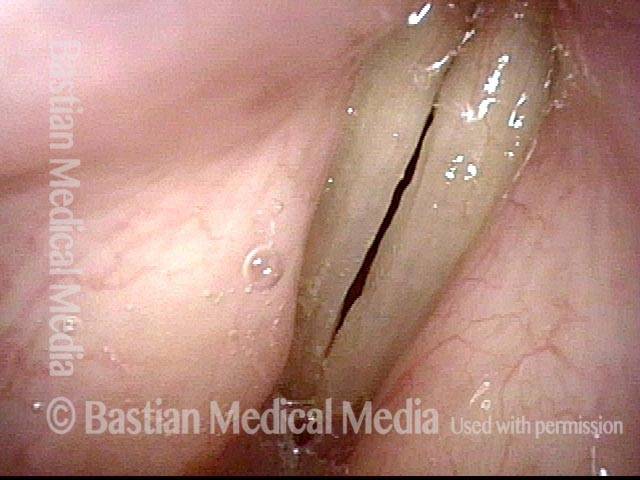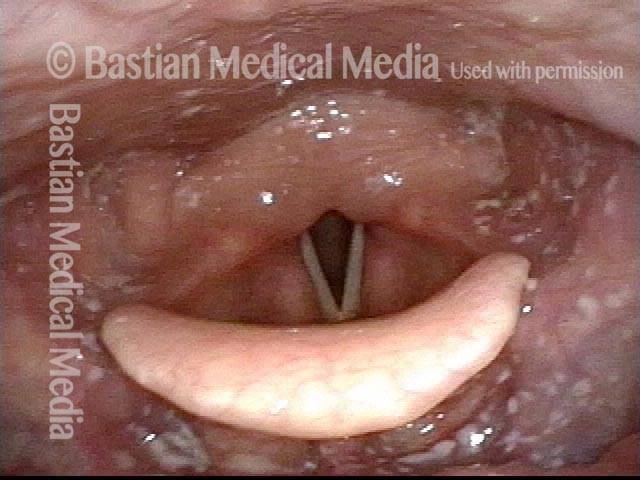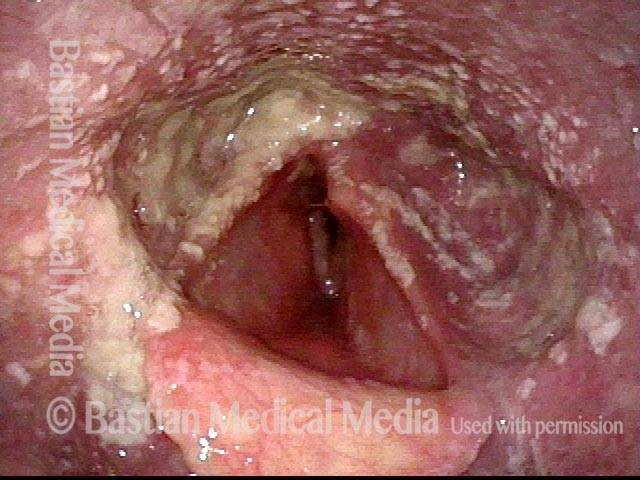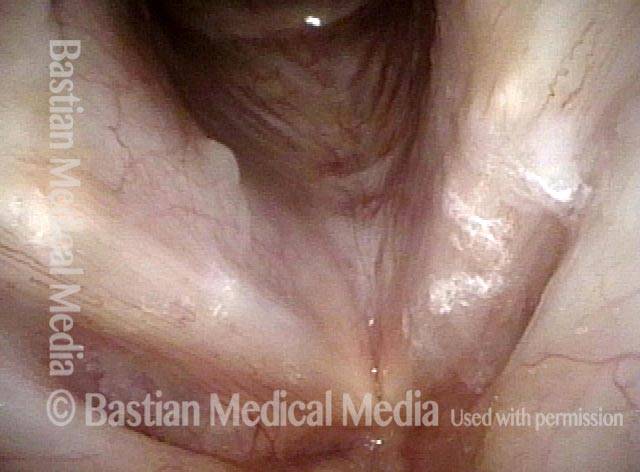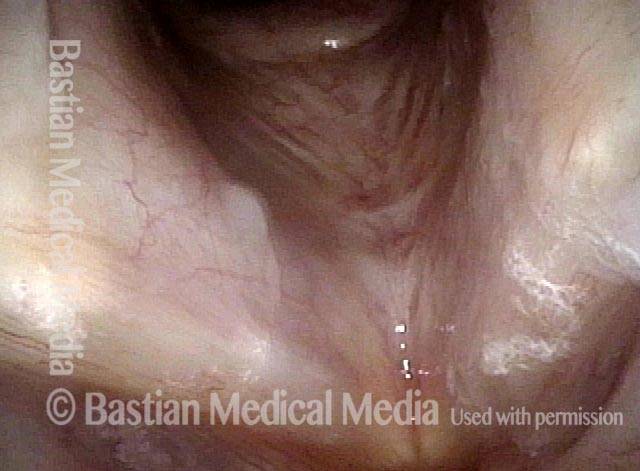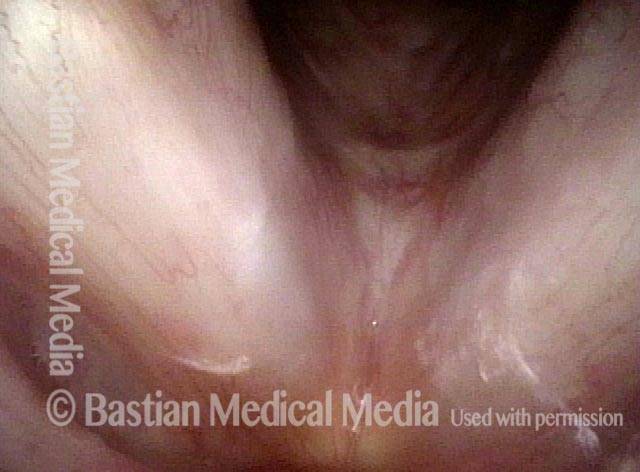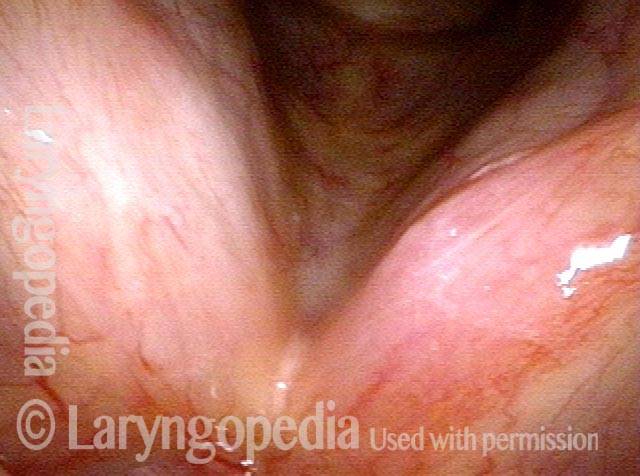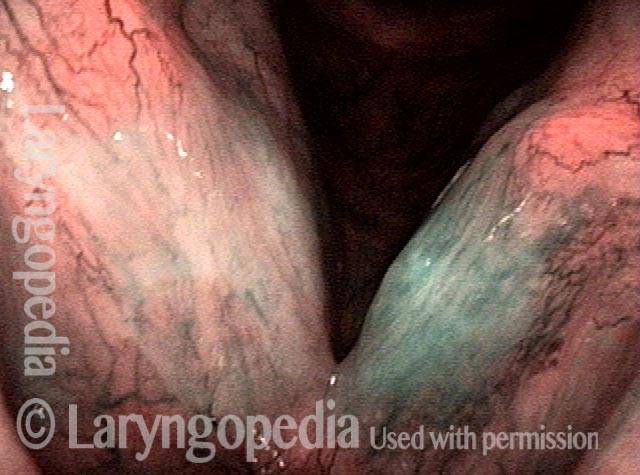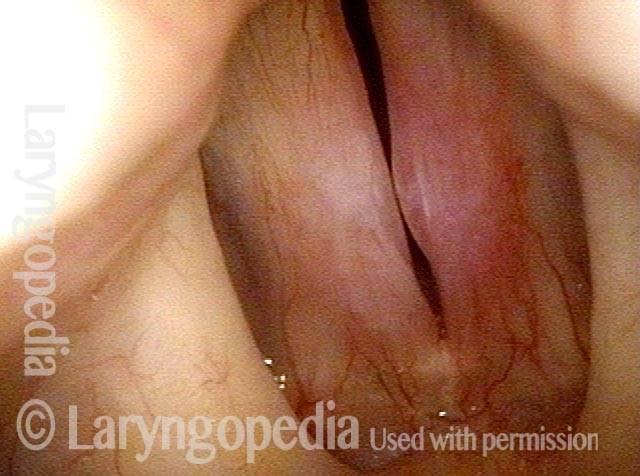Candida albicans is a fungal organism, normally part of human upper aerodigestive tract flora. Candida albicans may become pathogenic (creating a disease state) when there is a disturbance in the balance of other normal organisms. Such an imbalance may occur due to use of steroids, either taken by mouth or inhaled, as for asthma. Other causes of candida albicans overgrowth include use of broad-spectrum antibiotics, and/or immunosuppression. The resulting disease state in the upper aerodigestive tract may cause hoarseness or an outbreak of thrush.
Candida laryngitis, before and after treatment
Candida laryngitis (1 of 4)
Severe laryngeal candidiasis, in a person using inhaled steroids at high dose. Standard light.
Candida laryngitis (1 of 4)
Severe laryngeal candidiasis, in a person using inhaled steroids at high dose. Standard light.
Candida laryngitis (2 of 4)
Closer view shows more clearly not only the white areas, but also surrounding inflammation. Standard light.
Candida laryngitis (2 of 4)
Closer view shows more clearly not only the white areas, but also surrounding inflammation. Standard light.
Candida laryngitis, 15 days after starting treatment (3 of 4)
After 15 days of oral fluconazole. Obvious improvement, but incomplete resolution of tissue changes.
Candida laryngitis, 15 days after starting treatment (3 of 4)
After 15 days of oral fluconazole. Obvious improvement, but incomplete resolution of tissue changes.
Candida laryngitis, several months later (4 of 4)
After longer-term fluconazole, along with reduction of inhaled steroid dose, complete resolution. Strobe light, closed phase of vibration at high vocal pitch.
Candida laryngitis, several months later (4 of 4)
After longer-term fluconazole, along with reduction of inhaled steroid dose, complete resolution. Strobe light, closed phase of vibration at high vocal pitch.
Example 2
Candida laryngitis (1 of 4)
Candidiasis in patient using inhaled steroids for asthma. Under standard light, the lesions are vague, hazy, and best seen anteriorly on the right cord (left of image).
Candida laryngitis (1 of 4)
Candidiasis in patient using inhaled steroids for asthma. Under standard light, the lesions are vague, hazy, and best seen anteriorly on the right cord (left of image).
Candida laryngitis (2 of 4)
Same patient, narrow-band illumination. This not only emphasizes vascularity, but brings out the candida colonies.
Candida laryngitis (2 of 4)
Same patient, narrow-band illumination. This not only emphasizes vascularity, but brings out the candida colonies.
Candida laryngitis, after treatment (3 of 4)
After treatment with fluconazole, the colonies have virtually disappeared.
Candida laryngitis, after treatment (3 of 4)
After treatment with fluconazole, the colonies have virtually disappeared.
Candida laryngitis, after treatment (4 of 4)
Same post-treatment examination, under narrow-band illumination. Note that there are normal specks of mucus (such as at the arrows) in the view.
Candida laryngitis, after treatment (4 of 4)
Same post-treatment examination, under narrow-band illumination. Note that there are normal specks of mucus (such as at the arrows) in the view.
Example 3
Candida laryngitis (1 of 3)
Elderly woman with a history of laryngeal amyloidosis requiring laser sculpting several years earlier. Now using high-dose inhaled steroids, antibiotics, and oral steroids for unrelated pulmonary problem. Marked increase of hoarseness, and whitish discoloration, especially of the left vocal cord (right of image).
Candida laryngitis (1 of 3)
Elderly woman with a history of laryngeal amyloidosis requiring laser sculpting several years earlier. Now using high-dose inhaled steroids, antibiotics, and oral steroids for unrelated pulmonary problem. Marked increase of hoarseness, and whitish discoloration, especially of the left vocal cord (right of image).
Candida laryngitis (2 of 3)
Closer view of hazy white areas and irregular right cord margin (left of image), presumed to be candida overgrowth. Empiric treatment with fluconazole is justified, given history and findings.
Candida laryngitis (2 of 3)
Closer view of hazy white areas and irregular right cord margin (left of image), presumed to be candida overgrowth. Empiric treatment with fluconazole is justified, given history and findings.
Candida laryngitis, after starting treatment (3 of 3)
Two weeks after starting fluconazole; the white areas are completely resolved. The patient’s voice had improved markedly within three or four days of starting the treatment.
Candida laryngitis, after starting treatment (3 of 3)
Two weeks after starting fluconazole; the white areas are completely resolved. The patient’s voice had improved markedly within three or four days of starting the treatment.
Candida pharyngitis
Candida pharyngitis (1 of 2)
Countless candida colonies in the hypopharynx (lower throat) of a patient who, for treatment of an auto-immune disorder, is not only inhaling steroids but also taking high-dose steroids orally. Each tiny white dot represents a colony of the fungus.
Candida pharyngitis (1 of 2)
Countless candida colonies in the hypopharynx (lower throat) of a patient who, for treatment of an auto-immune disorder, is not only inhaling steroids but also taking high-dose steroids orally. Each tiny white dot represents a colony of the fungus.
Candida pharyngitis (2 of 2)
An even more dramatic case of candidiasis, in a different patient. Here, the colonies are more obvious and nearly confluent.
Candida pharyngitis (2 of 2)
An even more dramatic case of candidiasis, in a different patient. Here, the colonies are more obvious and nearly confluent.
Candida masquerader!
White lesions (1 of 3)
This man uses a steroid inhaler for his asthma. During esophagoscopy, white lesions were seen in the larynx and his GI Doctor sent him for evaluation of probable candida overgrowth. In all routine views, such as this one, white lesions are seen.
White lesions (1 of 3)
This man uses a steroid inhaler for his asthma. During esophagoscopy, white lesions were seen in the larynx and his GI Doctor sent him for evaluation of probable candida overgrowth. In all routine views, such as this one, white lesions are seen.
Candida colonies (2 of 3)
Candida colonies are routinely surrounded by a zone of erythema (see other photo series). No redness is seen here.
Candida colonies (2 of 3)
Candida colonies are routinely surrounded by a zone of erythema (see other photo series). No redness is seen here.
After throat clearing (3 of 3)
After aggressive throat clearing, the pattern of white lesions has changed, and this is of course another indication that we are not dealing with candida colonies here, but simple adherent mucus.
After throat clearing (3 of 3)
After aggressive throat clearing, the pattern of white lesions has changed, and this is of course another indication that we are not dealing with candida colonies here, but simple adherent mucus.
Hazy candida under 2 kinds of light
Haziness and redness (1 of 3)
This patient uses inhaled steroids and takes oral steroids as well. She has had prior episodes of documented Candida infection in prior years and has developed new laryngitis. Under standard light, both haziness (Candida) and redness (inflammatory response) are seen.
Haziness and redness (1 of 3)
This patient uses inhaled steroids and takes oral steroids as well. She has had prior episodes of documented Candida infection in prior years and has developed new laryngitis. Under standard light, both haziness (Candida) and redness (inflammatory response) are seen.
Leukoplakia (2 of 3)
Narrow band light shows the leukoplakia much more clearly. Candida on the vocal cords is often hazy and diffuse, presumably because the shearing effects of vibration do not allow the discrete, demarcated colonies often seen in other locations.
Leukoplakia (2 of 3)
Narrow band light shows the leukoplakia much more clearly. Candida on the vocal cords is often hazy and diffuse, presumably because the shearing effects of vibration do not allow the discrete, demarcated colonies often seen in other locations.
Swelling (3 of 3)
This individual is also highly talkative, and also has a swelling of the left vocal cord (right of photo) from vibratory injury. The inflammation present here may have facilitated this injury.
Swelling (3 of 3)
This individual is also highly talkative, and also has a swelling of the left vocal cord (right of photo) from vibratory injury. The inflammation present here may have facilitated this injury.
